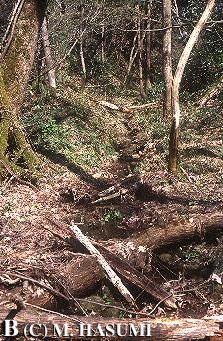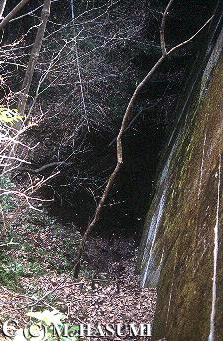


 | |
 |  |
(A) A body of slower-flowing streams with right and left abrupt slopes at an angle of approximately 70 degrees, formed at the outside of a sediment control dam. Breeding emigrants and immigrants of both sexes must climb up and down these slopes annually, as well as newly metamorphosed juveniles. Of H. lichenatus, there were 5 males with a typical aquatic-phase morph (characterized by increased head width, swollen body and cloacal region, and developed tailfin) and 40 pairs of egg sacs under stones or at twigs in the water. As an example, 27 and 29 eggs were counted in a pair of egg sacs.
(B) A swifter-flowing stream (riffle), forwarded to the outside of the dam mentioned above, involving 1 gravid female and 9 pairs of egg sacs among decaying leaves.
(C) A pool with a 6 x 4 m area and a water depth of 50 cm due to overflow, stored in the inside of another sediment control dam close to the site A, where 42 pairs of egg sacs were found at bamboo twigs or among mud in the bottom. Individual salamanders had bred in an upper stream (left side of this photograph) that flowed into this pool until the construction of the dam was completed about 20 years ago.
At the time of examination, we recognized a total of 5 males, 1 female, and 91 pairs of egg sacs of H. lichenatus. These egg sacs included embryos between the 2-cell stage and the tail-bud stage, with many being the neural-fold stage. I have heard the breeding seasons of many Japanese amphibians were delayed by much remaining snow this spring, but this population did not seem to have any delay for breeding, compared with my past records. Moreover, breeding individuals having a broken, regenerated, or questionable tail appeared frequently in this population (males: 31/44, 70.4%; females: 4/10, 40.0%; Hasumi and Iwasawa, 1987a).
Accompanied Research Collaborator: Iwao Hasegawa (Takefu-shi, Fukui Prefecture).